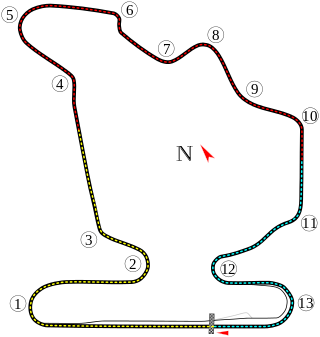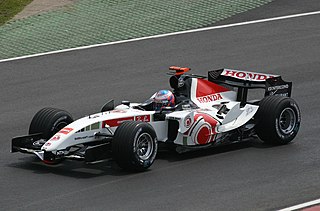
An open-wheel single-seater is a car with the wheels outside the car's main body, and usually having only one seat. Open-wheel cars contrast with street cars, sports cars, stock cars, and touring cars, which have their wheels below the body or inside fenders. Open-wheel cars are built both for road racing and oval track racing. Street-legal open-wheel cars, such as the Ariel Atom, are scarce as they are often impractical for everyday use.

Tatra is a Czech vehicle manufacturer from Kopřivnice. It is owned by the Tatra Trucks company, and it is the third oldest company in the world producing cars with an unbroken history. The company was founded in 1850 as Ignatz Schustala & Cie, in 1890 renamed in German Nesselsdorfer Wagenbau-Fabriksgesellschaft when it became a wagon and carriage manufacturer. In 1897, Tatra produced the first motor car in central Europe, the Präsident automobile. In 1918, it changed its name to Kopřivnická vozovka a.s., and in 1919 it changed from the Nesselsdorfer marque to the Tatra badge, named after the nearby Tatra Mountains on the Czechoslovak-Polish border.

The Cooper Car Company is a British car manufacturer founded in December 1947 by Charles Cooper and his son John Cooper. Together with John's boyhood friend, Eric Brandon, they began by building racing cars in Charles's small garage in Surbiton, Surrey, England, in 1946. Through the 1950s and early 1960s they reached motor racing's highest levels as their mid-engined, single-seat cars competed in both Formula One and the Indianapolis 500, and their Mini Cooper dominated rally racing. The Cooper name lives on in the Cooper versions of the Mini production cars that are built in England, but is now owned and marketed by BMW.

The Porsche 804 is a single-seat, open-wheeled racing car produced by Porsche to compete in Formula One (F1). It raced for a single season in 1962 in the 1½ litre formula.
The Alta Car and Engineering Company was a British sports and racing car manufacturer, commonly known simply as Alta. Their cars contested five FIA World Championship races between 1950 and 1952, as well as Grand Prix events prior to this. They also supplied engines to a small number of other constructors, most notably the Connaught and HWM teams.

The 1995 Hungarian Grand Prix was a Formula One motor race held on 13 August 1995 at the Hungaroring, Mogyoród, Pest, Hungary. It was the tenth race of the 1995 Formula One World Championship.
Takachiho "Taki" Inoue is a retired Japanese racing driver.
EuroBrun Racing was an Italian-licensed Formula One constructor based in Senago, Milan, Italy. They participated in 46 Grands Prix between 1988 and 1990, entering a total of 76 cars.

The Lotus 18 was a race car designed by Colin Chapman for use by Lotus in Formula Junior, Formula Two, and Formula One.

The Tatra 700 is a rear-engined luxury car released in 1996 by the Czech car maker Tatra. It was essentially a heavily restyled version of the Tatra 613 model it replaced. It is one of the last production cars with an air-cooled engine.

The Honda RA300 was a Formula One racing car produced by Honda Racing, and introduced towards the end of the 1967 Formula One season. It retained the same V12 engine as the preceding RA273 car, but the chassis was designed by Lola's Eric Broadley and based on a previous Lola Indianapolis 500 car, the T90. Internally, Lola designated the RA300 the T130. This collaboration resulted in the machine quickly being dubbed the "Hondola" by the motorsports press.

The Maserati 4CL and its derived sister model the Maserati 4CLT are single-seat open-wheel Grand Prix racing cars that were designed and built by Maserati. The 4CL was introduced at the beginning of the 1939 season, as a rival to the Alfa Romeo 158 and various ERA models in the voiturette class of international Grand Prix motor racing. Although racing ceased during World War II, the 4CL was one of the front running models at the resumption of racing in the late 1940s. Experiments with two-stage supercharging and tubular chassis construction eventually led to the introduction of the revised 4CLT model in 1948. The 4CLT was steadily upgraded and updated over the following two years, resulting in the ultimate 4CLT/50 model, introduced for the inaugural year of the Formula One World Championship in 1950. In the immediate post-war period, and the first two years of the Formula One category, the 4CLT was the car of choice for many privateer entrants, leading to numerous examples being involved in most races during this period.

The BAR 007 was a Formula One car used by British American Racing in the 2005 Formula One season. The car was driven by Jenson Button and Takuma Sato, although Sato was replaced by Anthony Davidson for the Malaysian Grand Prix as he had the flu. The team's test driver was Enrique Bernoldi along with Davidson.

The Tatra 603 is a large rear-engined luxury car which was produced by the Czechoslovak company Tatra from 1956 to 1975. It was a continuation of the series of Tatra streamlined sedans which began with the Tatra 77. In Socialist Czechoslovakia, only high-ranking party officials and heads of factories were driven in 603s; the car was also exported to a number of other countries.

The Tatra 12 is a model of vintage automobile made by Czech manufacturer Tatra. It was manufactured between 1926 and 1933. It was replaced by the Tatra 57 in 1932.

Rennzweier is a veteran automobile manufactured by Nesselsdorfer Wagenbau-Fabriks-Gesellschaft A.G. in 1900. It is sometimes also called First racing, 12 HP or Rennwagen. It was commissioned by baron Theodor von Liebig. Hans Ledwinka, the man behind the famous rear-engined Tatras, and at the time only 20 years old, took part in constructing the car. The car was manufactured on May 5, 1900, and the manufacturing process took only 5 weeks.

The Marussia MR03 is a Formula One racing car designed and built by the Marussia F1 Team. It competed for part of the 2014 Formula One season, before the team went into administration in November 2014. Following the team's resurrection as Manor Marussia F1, the car raced as the MR03B after modifications were made to enable it to compete in, and meet the regulations in place for, 2015.
The Subaru 1235 was a motor racing engine designed and built by Motori Moderni, and funded by Subaru for the Japanese manufacturer’s Formula One program in 1990. A 3.5-litre boxer-12, it was used by the Coloni team for the first eight races, but proved to be very unsuccessful and the team reverted to using the old Cosworth DFR V8 engine. Alba also used it in the World Sportscar Championship in 1990, but were similarly unsuccessful and switched to a 4.5-litre Buick V6 midway through the season.

The Tatra 72 was an army off-road truck model made by Czech manufacturer Tatra between 1933 and 1937. It was mainly used for transporting military cargo, personnel and towing artillery pieces in Czech and later German armies. The design was also license-built in France by Lorraine-Dietrich, as the Lorraine 72.

Ferrari manufactured a series of 3.0-litre, naturally-aspirated, V10 racing engines, exclusively for their Formula One race cars; between 1996 and 2005. They chose a V10 engine configuration, because it offered the best compromise between power and fuel efficiency; the V12 was powerful but thirsty, and vice versa for a V8. They switched to 2.4-litre naturally-aspirated V8 engine configuration for 2006. Over its decade-long evolution, power levels varied; from 715 hp @ 15,500 rpm in 1996, to over 900 horsepower, around 935 hp @ 19,000 rpm, toward the end of the 2005 season. The Tipo 05 series of engines, produced between 2001 and 2005, was officially stated to produce between 825 hp @ 17,800 rpm, and 865 hp @ 18,300 rpm. In qualifying mode, however, these engine were reputed to develop up to, or at times over, 900 horsepower (670 kW) at 19,000 rpm.
















